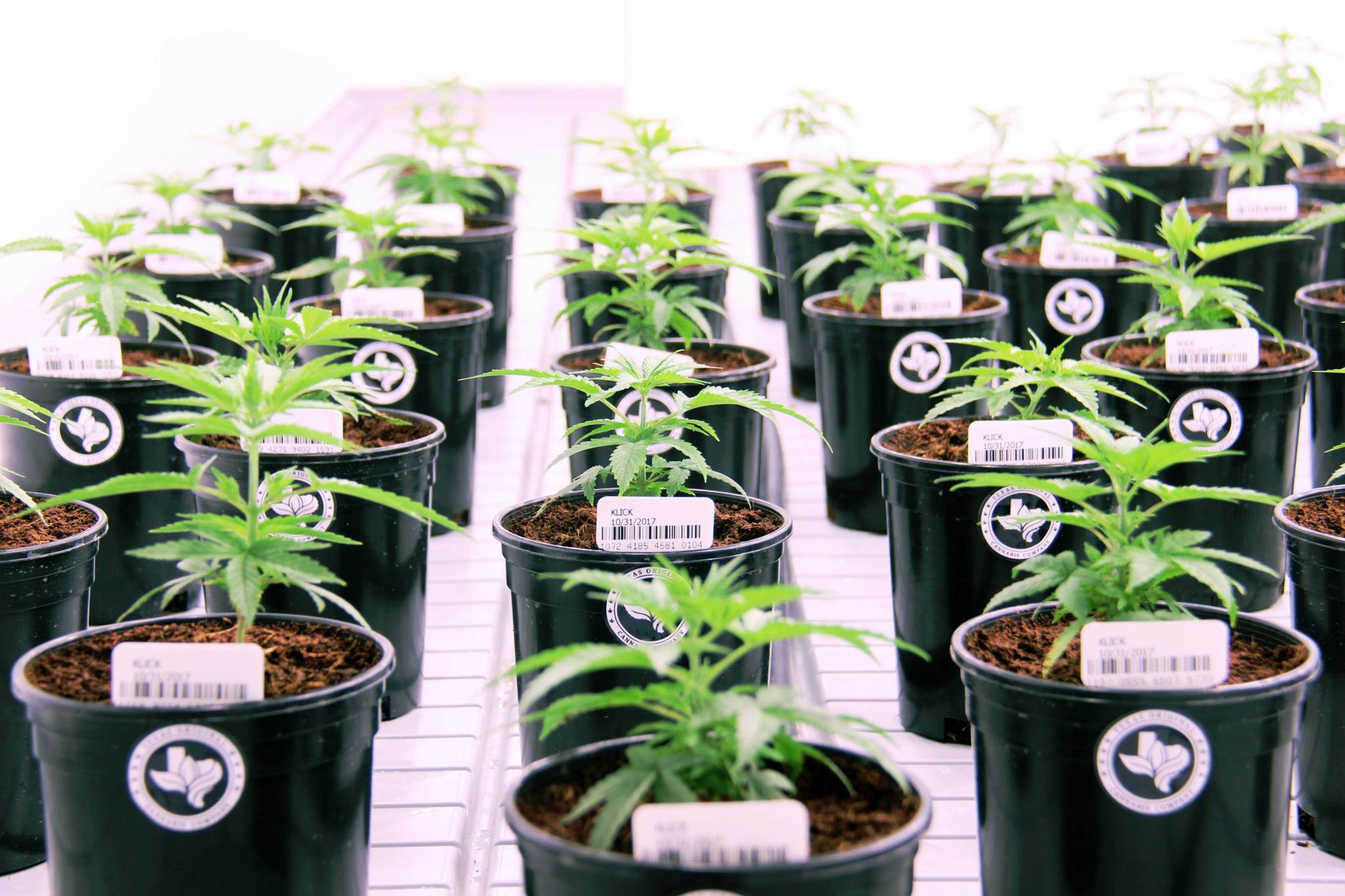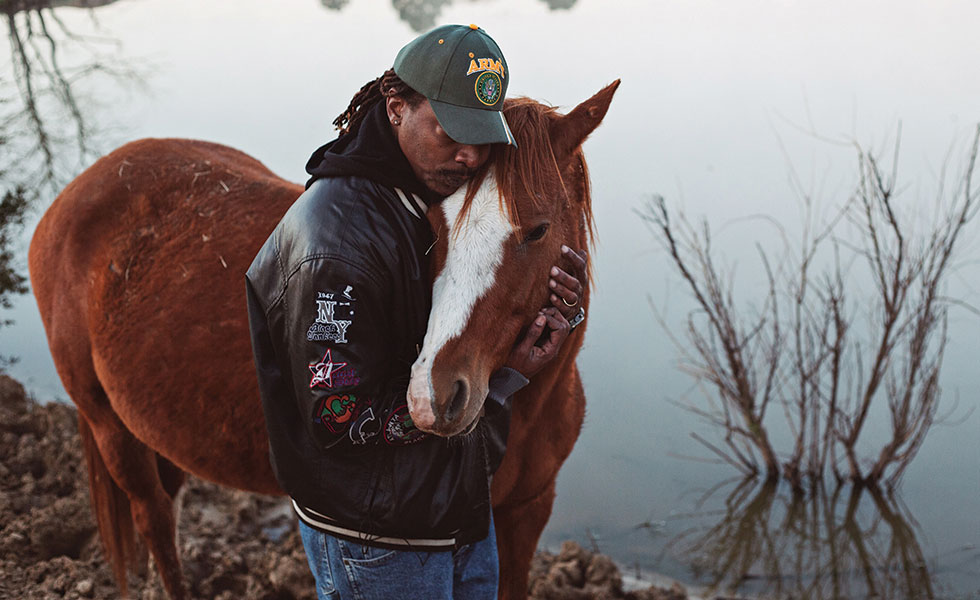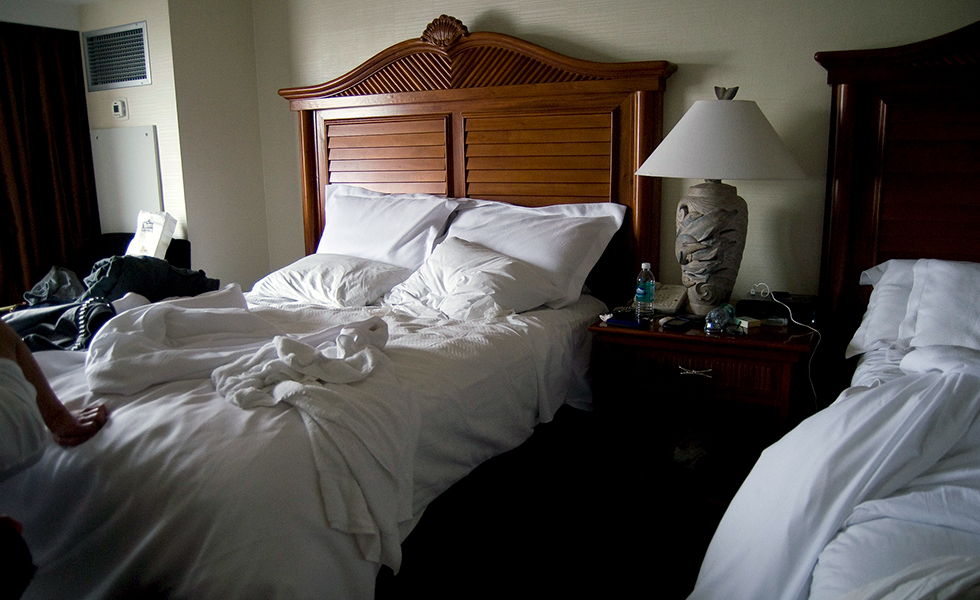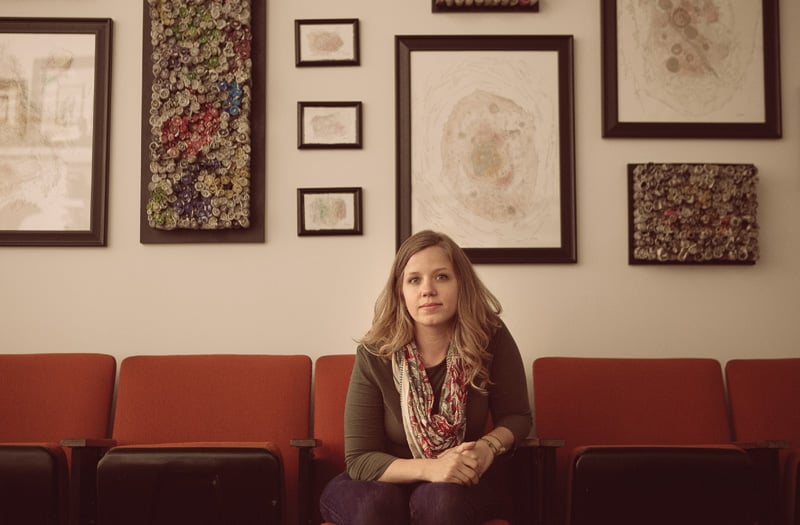
Hope After Violence
Women veterans are twice as likely as men to experience PTSD. We just don’t talk about it.

A version of this story ran in the June 2014 issue.
Above: Jenn Hassin, photographed at her studio at Big Medium in Austin.
Heather Diamani is not a victim. In fact, she’s reluctant to even repeat the acronym PTSD, so loaded has the term become, so likely is it to elicit sympathy—or worse, the assumption that she’s somehow broken and needs fixing. Diamani survived the Army. She survived two tours of Iraq. She survived the roadside bombs that tore through her Humvee.
And she is surviving the aftermath back home in Austin: the nightmares in which she believes she has lost her limbs; the chills she feels when a helicopter passes overhead; or when a motorbike backfires and she freezes, thinking, for a split second, it is a bomb; and whenever she smells burning trash and it takes her back to the Coyote Road—that dusty, deadly thoroughfare on the outskirts of Baghdad.
The condition is as old as war itself. It was once known as shell shock, a term coined during World War I to describe how combat frays the nerves of soldiers. It’s now called post-traumatic stress disorder or, more commonly, PTSD: a broader, more wide-ranging term that, according to the National Institute of Mental Health, is defined as damage to the brain’s natural “fight or flight” response, and which develops after a terrifying ordeal that involved physical harm or the threat of physical harm.
A person doesn’t have to be physically hurt to develop PTSD—an injury to a loved one or close friend can cause it. The latest Diagnostic and Statistical Manual of Mental Disorders says that this disturbance, “regardless of its trigger, causes clinically significant distress or impairment in the individual’s social interactions, capacity to work or other important areas of functioning.”
About 7.8 percent of Americans will experience PTSD at some point in their lives. For veterans of the wars in Iraq and Afghanistan, that number rises to 20 percent. And women are more than twice as likely to have PTSD as men. Women with PTSD are especially prevalent in Texas, which has the largest population of women veterans in the country, according to the U.S. Department of Veterans Affairs (Texas has 191,757 compared to California, the next largest, with 184,774).
Yet in the media coverage of PTSD and the toll this debilitating condition takes on military veterans, we rarely hear about women. For instance, an Observer review of news stories about veterans with PTSD in the Austin American-Statesman, Dallas Morning News and Houston Chronicle the past three years found that 73 percent reported solely on men; only 6 percent of the 71 stories sampled featured women exclusively.
That may be because we don’t normally think of women serving in combat roles. Until Congress lifted the ban in January 2013, women were forbidden from serving in combat.
But of course they did. In Iraq and Afghanistan, many women regularly came under enemy fire on the frontlines. Like Heather Diamani, they drove trucks; they worked as medics, radio operators and mechanics. Eight hundred women were injured in Iraq and Afghanistan; 143 died.
While the combat trauma these women experienced on the battlefield accounts for some of the PTSD diagnoses, it doesn’t account for all. According to the American Institutes for Research, a nonprofit that conducts social-science studies, approximately one in four women veterans has military sexual trauma, defined as sexual assault or repeated, threatening sexual harassment that occurred while they were serving. Estimates of the prevalence of sexual assault in the military among women veterans range from 20 percent to 48 percent. Either way, it’s staggeringly high. Eighty percent of women veterans have reported being sexually harassed. And some of them go on to develop PTSD. Women veterans are the silent sufferers—survivors—in the aftermath of America’s military adventures in the Middle East.
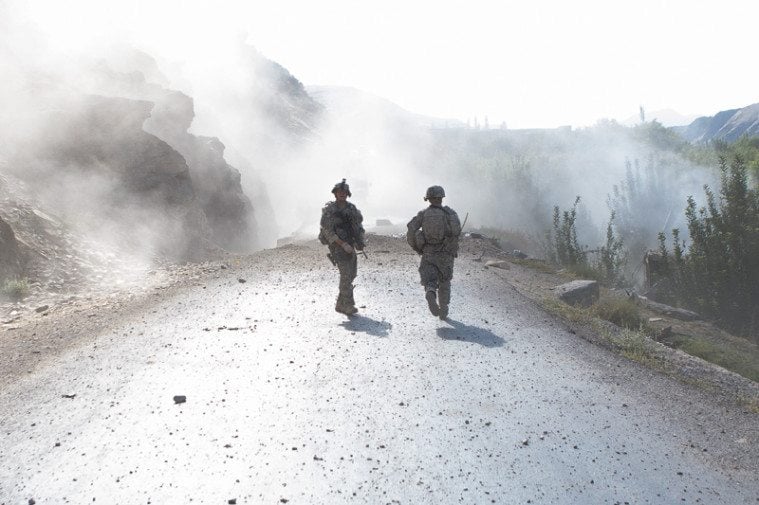
Heather Diamani was born in Massachusetts and grew up in New Hampshire. She wanted to travel and have a challenging career, so she decided to enlist in the U.S. Army. She was athletic and liked the idea of what she calls “the mental game”—the way the military breaks you down and builds you back up.
When she entered the Army, she says, she was “the nicest, happiest person. I was raised to be non-judgmental, open-minded, loving.” At the basic training base in Missouri, her friendliness caused one superior to tell her it seemed like she was flirting. “So I went really quiet,” she says. “And I went from quiet to bitter.”
Diamani went into advanced individual training where she learned to drive trucks and administer first aid. She practiced rollover drills, and learned how to insert an IV, treat a punctured lung and apply tourniquets. “They prepare you for everything,” she says, “but nothing prepares you for explosions and people dying.”
In spring 2005, she deployed to Iraq. One night, just a week in, mortars rained down on the pod of trailers that served as her unit’s sleeping quarters. Diamani ran outside and saw soldiers from various platoons running toward a bunker. “All I could think was, ‘Holy crap, this is my platoon. They’re like my brothers,’” she says. She grabbed her gear and ran toward the bunker too; that’s when she saw a lieutenant from another platoon lying on the ground, and then she saw a captain, the lower half of his body missing. “Everyone’s shouting ‘Get in the bunker, medics are coming.’ And I’m like…this is insane. I don’t know if they ever made it.”
Another time, Diamani was preparing for a mission when a suicide bomber blew himself up at the outer gate of the military compound. “There was this huge hole in the ground,” she says, “and so many people scattered around injured.”
She still has nightmares about the captain, except in her dream, he’s lying not outside the pod of trailers but by the gate in the aftermath of that second explosion. And in the dream, Diamani tries to save him but can’t. “My counselor says it’s survivor’s remorse,” she says.
The first time an improvised explosive device (IED) hit her truck, Diamani says, it wasn’t such a big deal—“like a little shake, pathetic.” That first year her Light Medium Tactical Vehicle, a large desert-colored truck with a flat bed, wasn’t even armored. Another time she was driving a Humvee and someone fired a rocket-propelled grenade at the vehicle. “I kept telling upper command I didn’t think it was a good idea driving that route,” Diamani says. “We’d been at the same checkpoint every day, and we were like squatting ducks. I didn’t have a good feeling about it. And sure enough…”
The missile went over the truck and into an adjacent field. Diamani and her unit spent the rest of the night driving around looking for the perpetrators.
On another occasion an IED exploded between Diamani’s vehicle and a trailing tank. The blast hit the rear of the Humvee, but no one was injured.
Next time this happened though, it was, in her words, the big one: “We were on the route to Tarmiyah [about 15 miles north of Baghdad]. On Coyote Road—the most dangerous route.” A few months earlier, Diamani had lost her friend Joey Cantrell on that same route. Cantrell was a 23-year-old medic, and his Humvee struck a roadside bomb. Diamani had traveled to Qatar with Cantrell and another colleague after winning a soldier-of-the-month commendation. They’d become a tight-knit group and had promised to stay in touch after the war. His death devastated her. Yet here was Diamani driving the same Coyote Road on which Cantrell had been killed. She had her headset on—one earphone scanning her military radio, and the other to listen to her music: Audioslave’s “I Am The Highway.” She’ll never forget it. When the blast hit, the vehicle lifted off the ground. The IED had detonated under the front of the Humvee. “It was nuts,” she says. “I just remember my first reaction was to look down at my legs, and I saw they were still there and started laughing. It was the only thing I could do.”
Diamani had been trained to keep driving no matter what damage had been done, so she drove out of the kill zone to safety. Diamani and the other two soldiers with her inside the Humvee eventually got combat action badges. Her vehicle was assessed for damage, but nobody asked how they were feeling. “It was always, ‘What’s the situation? Can we find the person who did it? How’s the truck?’ I never once was asked whether I had any injuries,” Diamani says. “Was I hurting? How was I mentally? Nothing. It was weird.”
After six years in the Army and two deployments to Iraq, including a promotion to sergeant, she felt the grueling routine of war—driving a truck hundreds of miles, carrying a 50-pound pack (Diamani weighs 115 pounds), holstering a weapon on her shoulder and wearing a flak vest—begin to take a toll on her body.At one point she was hospitalized in Baghdad. Her back would swell so badly she couldn’t walk. The doctor at the walk-in clinic gave her a shot of cortisone and ice packs, and she lay on a gurney. “And all of a sudden this guy gets wheeled in, and he has a gunshot wound in the neck,” she says. “He’s right beside me, and I just look over and think, ‘Oh my God, that’s the saddest thing.’ I asked the nurse if he was going to be okay and she said it wasn’t looking good.
“I got off my bed, went over to him and held his hand. I don’t remember how much time passed but all of a sudden he starts going. They start freaking out, and he’s dead. It was so heartbreaking. That’s when I started crying my eyes out. I asked the medic how she was able to do that job, and she said they get numb to it.
“I just felt like an asshole being in the medic station with a back injury, so I left. It’s so weird how that gave me the strength to mentally get over the pain I was feeling. That’s kind of how I deal with stuff now. When I start to feel any pain now, that’s how I deal with it. That’s how I cope.”
Out of the Army and living in Austin, Diamani is reminded of her tours every day. There’s a smell she can’t forget; it’s burned into her senses: the smell of human carcasses. She still has physical injuries: a crooked spine and cartilage degeneration in her neck. She also suffered damage to the nerves in her shoulder where she carried her weapon for years. Then there were the mental injuries.
She went to therapy, but ended up splitting from her first husband, also a soldier and also suffering from PTSD. She says she lost sight of who she was and found herself alone. But that’s when she began to turn her life around. The first year was the hardest, but she says the Department of Veterans Affairs was there for her, providing support and treatment. The daytime flashbacks are gone, but she has no control over the night. “I can’t stop the nightmares,” she says. “They happen weekly. They’re always going to happen.
“I still get night sweats a lot. I wake up, throw the covers off and look down at my legs. That’s my biggest nightmare. I keep thinking my legs have been blown off.” When she was deployed in Iraq, Diamani received word that her uncle had been in a bad car accident, and he’d woken up in the hospital to find that his legs had been amputated. That, she’s convinced, is the trigger for her dreams.
“There’s not a day that I don’t feel physical pain, but I don’t talk about it,” Diamani says. “I walk around, and I play sports regardless. I’ll live my life, because I still have the ability to do that. I refuse to take painkillers, and I feel that if I don’t identify myself by a disease or an injury I can have the best life possible. I’ve seen people pilled-up in bed, and I can’t live like that. I’ve been chosen for a reason to still be here. I remind myself of that, because it helps me cope.”

Kimberly Olson, a retired U.S. Air Force colonel and pilot, says that in Iraq and Afghanistan women were always in combat. Now chief executive and president of Grace After Fire, a Texas-based nonprofit that helps women veterans, Olson says women may have been working primarily in support roles during the wars, “but right next to the door-kickers was the female linguist. And she’s at just as much risk as the door-kickers. Women were going to get killed, maimed, and exposed to what men have been exposed to in warfare.”
Olson says women who experience traumatic injury after their military service show it in different ways than men: “A lot of us don’t self-identify as former military, unlike our male counterparts. Forty percent of women veterans have school-age kids. We step back into being a wife, a mom, the breadwinner. We bury our military service 10 items down in terms of who we are.”
Male veterans with PTSD, Olson says, “are pissed off with the world. Women don’t do that. We bury it in our guts. We get depressed, overweight. We suffer from hypertension. We don’t act out like a guy will. But that’s how men normally handle stress—as external behavior. I’m generalizing, but women tend not to act out. They isolate themselves. And an isolated veteran is a suicide risk.”
One study, published in 2010 by the journal Psychiatric Services, said female veterans between ages 18 and 34 are three times more likely than their civilian peers to commit suicide. One of the reasons, Olson says, is that women who have been in the military understand weapons. They’ll put a gun to their head rather than swallow pills.
In February, a survey of women service members returning from war coordinated by the Houston Area Women Veterans Community Council attempted to convey what it described as the “unique challenges faced by female veterans returning from active duty.” Seventy percent of respondents said they found returning to civilian life more difficult than anticipated, noting “the general lack of support for women, along with an array of issues related to physical and mental health.
“Female veterans face an array of challenges that are separate and distinct from those experienced by their male counterparts,” the report said. “Military Sexual Trauma [MST] was high on the list of experiences that prevent a smooth transition. Lack of targeted mental and physical health services is undeniable, and there appears to be a discomfort within the traditional male branches of the military when it comes to addressing women’s unique physical and mental health requirements. It is not surprising that female veterans feel betrayed when it comes to acknowledgement of their service and appreciation for their sacrifice.”
More than half of women veterans say they experienced some type of “interpersonal violence” before they even enlisted. Between 27 percent and 49 percent were subjected to sexual abuse as a child, and as adults 24 percent to 49 percent were sexually assaulted, according to the American Institutes for Research.
Frank Ochberg, a leading trauma psychiatrist who was part of the board that defined PTSD in the late 1970s, says there’s a difference in the trauma that can lead to PTSD. “PTSD is one way of showing the pain of having dealt with evil or cruelty or sudden tragic loss, but there are other ways as well,” he says. “The kind of trauma where you’re confined, overpowered—when you are held down and then hurt, it’s different from being out there and suddenly from out of nowhere there’s an IED or an explosion. When you are captured first and denied the chance to fight or flee, as is the case with military sexual trauma, the odds of a PTSD response go right up. And it is women who are facing that.
“And,” Ochberg says, “I would add this: When it’s military sexual trauma, it’s our own guys doing it to our own women. It’s in the family, so it’s like incest, and it has all the problems associated with incest. The military depends on being a family, so when it’s your father figure or brother figure doing it to you, it’s like your father or brother doing it to you at home.
“When that happens, it’s not just sex. It’s secrecy, shame, dishonor, and in the theater of military action, honor is so important. It’s what you fight for. It’s what holds you together. When you break that code of honor, it takes away the reason you risk your life.”
Jenn Hassin is not a victim, either. She never served overseas and therefore she never had, as she puts it, “bullets flying by my head,” but she survived sexual assault by a superior and is surviving the effects of her PTSD.
Life was tough growing up in the small Texas community of Eagle Lake. Hassin was sexually assaulted as a child. Her family was poor, and she was waiting tables before she turned 12, helping pay the water bill in the two-bedroom trailer where she lived with her mom, dad and siblings. She has three elder brothers, each of whom joined the Navy, and two younger sisters.
She joined the Air Force in 2005 and was sent to train at Lackland Air Force Base in San Antonio. One of her female instructors would shout at her, but a male instructor was nice to her from the outset and initially she felt relieved. “A few days later I realized he was flirting,” she says. “I just kind of ignored him at first, then a week later he was asking what kind of music I wanted to listen to during training.”
The instructor began asking personal questions about her home life. There was an elderly man from her hometown who had always treated Hassin like a granddaughter and sent her mail while she was going through basic training. Her instructor—who she doesn’t want to name for fear of repercussions—would tease her with the letters, pretending that he wasn’t going to give them to her. “And he was kind of flirting the way he’d do it,” she says.
Then one evening his voice came over the intercom, instructing Hassin to come to the charge of quarters office where he was stationed for the night. She reported to the office at 9:15 p.m., just 30 minutes before taps played—the tune, on a solitary bugle, that is broadcast at dusk on military bases to honor service members who have lost their lives.
“He told me to stand at ease and began making small talk,” Hassin says. “He didn’t have anything for me to do, so I asked what it was about.” Her instructor said he needed a cover story to bring her to the office, and she told him that was inappropriate. As taps began playing and Hassin stood to attention, he moved toward her. “He started feeling me up and grasping at me,” she says. “He started bending me over the desk, and I freaked out. I told him to get off me, but he was completely forceful, violent, and I completely wigged out and began crying. He started kissing me. It was pretty traumatic. He didn’t rape me, but he was all over me and groping me, and he told me that we would see each other again and that he knew I wanted him.”
Hassin says the instructor told her not to tell anyone. “Typical fucking stuff,” she says, “and of course I didn’t say anything. I didn’t report him. Then a couple of days go by, and he was still acting like nothing happened, that everything was fine, and he gives me my mail.”
Included in her mail was a letter from him with a map and directions to his house. She told him she wouldn’t go, and he said they’d have to find some “alone time” on base instead. But the next day Hassin and her squadron were practicing marching moves when she tore her ACL and was sent to medical quarters: “He was alone with me in there a couple of times, and he came up to make a move on me, and I told him flat out: If he sent me to med flight—where I’d get med-boarded out of the military—I would report him. I’d only been in less than 90 days. I’d get no benefits. And secondly, I said, if you make one fucking move on me, I’ll tell on you.”
Hassin completed her training in Wichita Falls—“running, doing push-ups, all on my torn ACL”—then trained as a dental technician and was sent to RAF Lakenheath, a base in England. Once she arrived, she went to see the base psychiatrist and that’s when she first explained what had happened to her back in Texas. “She told me to think about it rationally: that my training instructor was probably doing this to someone else,” Hassin says. “She told me I was a strong chick, but that he was probably doing it to somebody who wasn’t as strong. And I hadn’t even thought about that. He’s just a filthy asshole, just messing with people. That he’s just doing this ’cause he can, because he’s got this power as a training instructor, and the Air Force doesn’t even know.”
Hassin had to testify against the instructor at a hearing, and that’s when she discovered he’d targeted other women too. “There were several girls at his court martial,” she says. “He tried to say he wasn’t guilty. He had an on-base address, with a wife and family, and it turned out this apartment he’d written down for me to visit wasn’t his. He sublet it from some other guy—this piece of shit apartment in San Antonio where he just took girls to fuck them. He was a piece of shit. Now I know this asshole did it to so many girls. I didn’t do shit wrong. Predators know how to seek out girls and that’s the truth of it.”
In 2007, he was handed a prison sentence for the sexual assaults. In fact, sexual assault was a rampant problem at Lackland, which in 2011-2012 was the subject of a major scandal. Seventeen instructors would be convicted of misconduct with trainees. According to Air Force Times, reports of military sexual assaults rose by 50 percent last year. Pentagon officials have said the increase was the result of more troops coming forward to report sexual assaults, seeking help and offering information for prosecuting offenders.
Although she’s no longer in the military, Hassin still deals with the trauma. When she hears taps today, it brings the memories flooding back. “It’s so fucked up because that tune honors service members,” she says. “For a little while, it bothered the shit out of me every time, but now I’ve learned to let it go. I’m not a victim any more. I’m totally OK. And believe it or not, I wouldn’t change anything about my past—not anything that happened when I was a little girl either. Because I’m stronger.”
Olson, the retired Air Force colonel, says what happens to people like Jenn Hassin is a betrayal of trust in a system to which these women swore to give their lives. “More women are raped and assaulted in training environments than they ever were overseas,” Olson says. “And not only is that bad, but there’s a second victimization where [many women] can’t get justice and can’t move on. Justice is important to civilians just like it is to military women. The system can’t seem to be accountable to itself.”
Olson says there are three things that need changing: In training—and the Marines, she says, have one of the worst reputations—the military uses the female gender to motivate men. “They call them sisters, women and sissies. They portray the female gender as less valuable even though she’s wearing the same uniform.”
Olson also says that women’s needs in recovery are different than men’s, and the military needs to acknowledge that fact. “If women are wired to nurture and love,” she says, “[trauma] probably does have a greater impact on them. That’s where the system is failing. There is not enough research around women in warfare. They treat them like small men. But they’re not.”
Greg Jacob, a former U.S. Marine and now policy director of the Service Women’s Action Network (SWAN), says the Department of Veterans Affairs was historically designed to help men—in both policies and treatment. Though the Veterans Health Administration has been responsive to issues of sexual trauma—Jacob says it provides sexual trauma coordinators and now screens for sexual assault—“there are still issues.”
Only 15 percent of women eligible for VA care actually get it, he says. In the veterans community, it’s difficult to get women to identify as veterans largely because they were banned from combat roles. “But we have more than 250,000 women veterans in America who served in Iraq and Afghanistan, and there’s likely to be half a million when both those conflicts have wound down,” Jacob says. “They’ve been on the front lines, experiencing injuries, visible or invisible wounds. And yet at the VA, they’re being asked if they’re waiting for their husbands, or they get hit on. These are major problems.”
Then there are the societal problems—homelessness, unemployment, suicide—that affect all veterans. As Jacob says, if women aren’t even plugged into a system that can help them—if they’re not even part of that network—what chance do they have?
Jacob’s group has talked to women who have experienced both sexual and combat trauma and have submitted two PTSD claims, one for each trauma. But Jacob says many dropped the sexual trauma claim because they didn’t think they had a chance of getting treatment for it. And statistics show they could be right. Jacob’s group submitted two Freedom of Information Act requests that show a disparity: the VA is more likely to approve claims for PTSD caused by combat than claims for PTSD caused by sexual trauma.
Jacob’s information request showed that at the VA regional office in Waco in 2012, 75 percent of combat PTSD claims were approved versus 67 percent of sexual assault PTSD claims. The year before the disparity was starker: The Waco VA approved 77 percent of combat claims but just 47 percent of those who wanted treatment for sexual assault trauma.
“And they’re far from the worst,” Jacob says. “St. Paul, Minnesota, had a 20 percent approval rating for [sexual assault] PTSD claims. The gap in approval rates for [sexual assault] PTSD claims and combat PTSD claims is huge. And there shouldn’t be any inequity.”
Today Jenn Hassin is married, has a 5-year-old son, and works as a mixed-materials artist in Austin. “I once thought I’d go back into the military as an officer,” Hassin says, “but I didn’t want to be a mom in combat boots. Plus I’d probably have been deployed, and my husband would never be okay with me joining up again.
“I’ve become a survivor through time and through telling my story and through realizing that it’s not the end of the world and that I have this whole life ahead of me. It’s not worth living in the past because there’s nothing I can do to change it.”
She points to a piece of artwork on the shelf at her studio. It’s a picture of a bird with nails hammered into it. “Every single one of those nails represents somebody who was raped in Austin last year,” she tells me. “There are 209 large nails. The 645 smaller nails represent the 645 children who were reported molested in Austin last year. And they are just the numbers that were reported.
“They’re nailed into a red dove. Red is for courage and the dove is for hope—because in my opinion that’s what it takes to get past sexual violence and become a survivor; that there’s hope after violence.”
